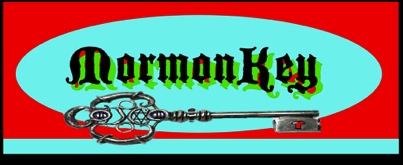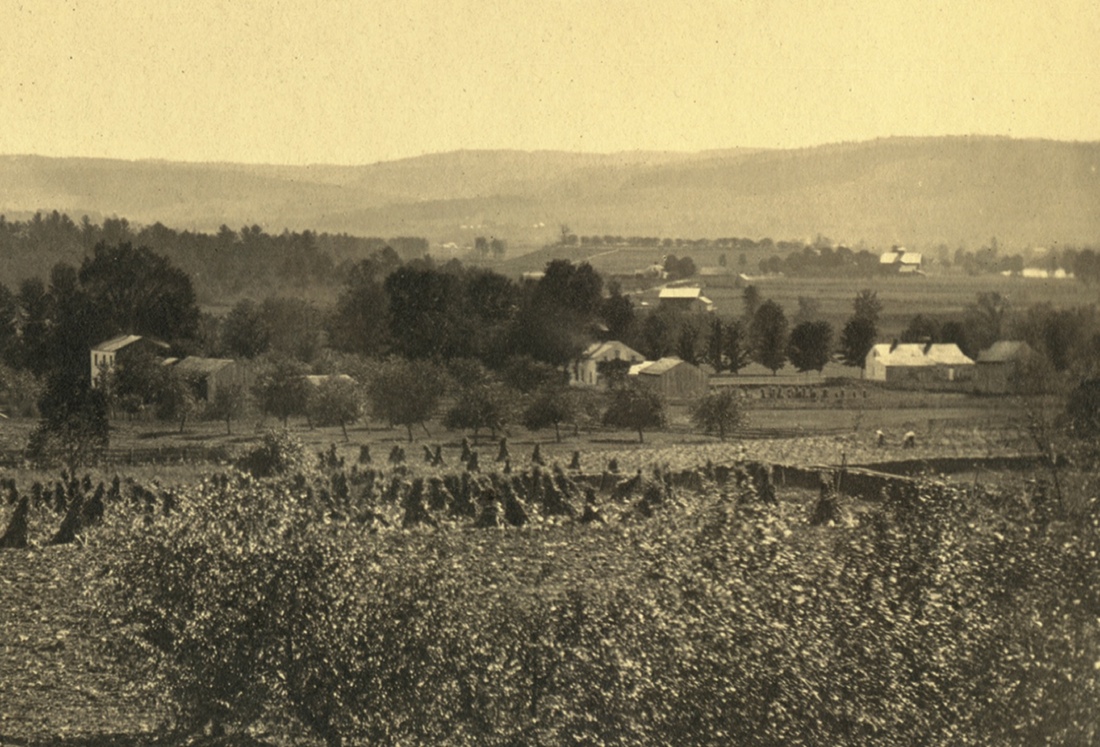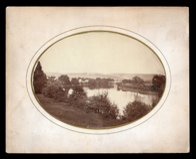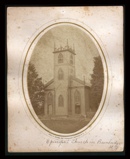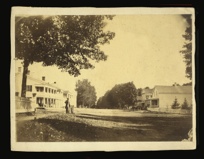A study of the life and times of Prophet Joseph Smith, Jr. is not complete until one has become, at the least, generally acquainted with the grand saga's earlier aspects of the Prophet's initial journey led by the Lord, as it occurred almost two centuries ago.
As well, in this the 21st century, finally getting to truly 'see' what Bainbridge actually looked like in the days of Joseph Smith, lends more in keeping the spirit at heart; of the Prophet. Actually seeing what it was like where Joseph Smith once stood, in the days before there became a proliferation of macadam and asphalt roads and before there was telegraph and telegraph poles everywhere, and then automobiles - all essentially elevates one's feeling of the experience all as if almost seen through Joseph Smith, Jr. himself's very own eyes! One's mind can take one there.
Seeing just about as the Prophet saw it - lends more in keeping the spirit, in the spirit of the life and times of Prophet Joseph Smith - alive.
From about 1819, Smith regularly practiced the art of what has been refered to as "scrying," which was a supposed form of divination in which a "seer" would look into a "seer stone" to receive supernatural knowledge - as if the seer stone beheld some sort of receptive transmissive powers.
In today's terms, it would seem to be regarded much akin to a scene taken out of a Harry Potter novel.
Myriads of accounts also place Smith at having practiced “crystal gazing.”
Joseph Smith, Jr. enacted these various supranatural efforts by, in one instance putting a stone at the bottom of a white stovepipe hat and then positioning his face over the hat to block out extraneous light, and with this action by Joseph, subsequently was said to divine information from the stone.
Then there are accounts of Joseph Smith’s use of a “peep stone.” This is significant in that there are actually some surviving facsimile examples of the original form Smith used “peep stone” handed down in the Whitmer family.
However, when examined, these stones are simply elongated slightly bowl shaped solid stones that have one small hole chiseled out in the center spot. However, as one well knows, a stone is not translucent or transparent like that of a crystal. Yet, we do have surviving, numerous printed accounts that Joseph Smith, Jr. practiced “crystal gazing.”
What is significant here is that early 19th century New York State court records clearly substantiate and reveal that Smith had been identified as being "The Glass Looker.” He was not identified as a "Peep Stone Looker," but a "Glass Looker."
It was before a Bainbridge, New York magistrate judge that Joseph Smith, Jr. found himself standing on March 20, 1826, there on a warrant for an unspecified misdemeanor charge. The extant court record describes Smith as a “Glass Looker.” The word “glass” denotes a “crystal.”
Thus, it can be safely construed that in order to “crystal gaze” one must suitably employ a translucent or reasonably clear “crystal” and not a solid stone or a solid “peep stone” merely with a hole in it. Perhaps however both a "peep stone" was used in conjunction with a "crystal."
This dichotomy is confusing, which leads one to think that presumably there might be more to all of this for which details may in fact have been lost over time. This all may become more significant than one might think, when this discussion is looked at more definitively in the subscriber section of this forum.
According to Richard N. Ostling and Joan K. Ostling, in their 1999 book Mormon America: The Power and The Promise, Joseph Smith, Jr. had practiced the art of ’peep stone’ / ‘crystal gazing’ with his father. In their book, the Ostlings' state that the Smiths garnered "something of a mysterious local reputation in the profession - mysterious because there is no record that they ever found anything despite the readiness of some local residents to pay for their efforts."
In late 1825, a well-to-do farmer named Josiah Stowell of South Bainbridge, Chenango County, New York sought out the services of Joseph Smith, Jr. At the time, farmer Stowell had been actively searching for a lost Spanish mine near Harmony Township, Susquehanna County, Pennsylvania.
Apparently based on old American Indian legend, Stowell believed such a mine existed and that the bounty would be of untold riches in the form of a good vein of precious metal the likes of gold or silver. Plus precious metal bars, Spanish doubloons long forgotten, would be found, or so Stowell had hoped for.
Hearing about Joseph Smith, Jr’s “crystal gazing” exploits and widely acclaimed expertise, and learning that Smith, Jr. lived in Manchester, New York, just outside of Palmyra, Stowell set out to travel the long near 200 mile trek by wagon to Manchester to hire Smith. Stowell was accompanied by William Hale, also a “seer” of sorts, and good friend.
According to Dan Vogel in his 2004 book Joseph Smith: The Making of a Prophet, Stowell sought to hire Smith ”on account of having heard that he possessed certain keys, by which he could discern things invisible to the natural eye."
Smith agreed to take the job of assisting Stowell and Hale, and Smith, aided by his father Joseph Smith, Sr. - traveled to Harmony, Pennsylvania and began working with Stowell and Hale. This work engagement is said to have lasted for approximately one month. According to the Smiths’ contract, the two agreed to locate "a valuable mine of either Gold or Silver and also........, coined money and bars or ingots of Gold or Silver.”
While in the Harmony area, Smith boarded with a William Hale relative named Isaac Hale. This arrangement in turn led to Smith having the occasion to meet Isaac Hale's daughter Emma Hale.
Miss Hale was a schoolteacher Joseph Smith, Jr. would later marry in 1827. Isaac Hale however was not especially fond of Smith and disapproved of his daughter having any sort of relationship with Smith in general. One account given by Isaac Hale, although essentially unsupported, claimed Smith attempted to locate the mine with the technique he used by burying his face in a hat containing the seer stone, but the effort did not seem to be effective in this particular instance, for as the treasure hunters appeared to get close to their goal, Smith suddenly found that the enchantment surrounding his actions became so strong that Smith himself could no longer see anything; the signalled imagery transmission of the hoped for Spanish mine location suddenly ceased.
By November 1826, Josiah Stowell could no longer afford to continue searching for buried treasure. Like a water well sometimes would do, his project's funds had run dry.
In turn, Smith traveled to Colesville, New York for a few months to work for Joseph Knight, Sr., one of Josiah Stowell's close friends. There are reports that Smith directed further excavations via his "peep stone" or "crystal gazing" technique on Knight's property and at other locations around Colesville.
About his working as a treasure hunter, in the 1971 book No Man Knows My History: The Life of Joseph Smith by Fawn M. Brodie, it is stated: "'Was not Joseph Smith a money digger?' Yes, but it was never a very profitable job for him, as he only got fourteen dollars a month for it."
Because of such lack of productivity, and Stowell running dry on funds, the mine search efforts subsequently failed and the project disbanded on 17 November 1825. This is all based on the account given by Eber Dudley Howe in his 1834 Mormonism Unvailed, published at Painesville, Ohio.
However, some spurious accounts claimed Smith continued to work for Stowell on other matters until 1826.
In 1826, not long into the new year, Smith was arrested and brought to court in Bainbridge, New York, on the complaint of Stowell's nephew who accused Smith of being "a disorderly person and an imposter." Court records show that Smith was known as "The Glass Looker," and it was here at Bainbridge that he stood before the court on 20 March 1826. Court records state Joseph Smith. Jr. faced the judge on a warrant for an unspecified misdemeanor charge, and with this the judge issued a mittimus for Smith to be held, either during or after the proceedings.
Although Smith's associate Oliver Cowdery later stated that Smith was "honorably acquitted," the proceeding’s ending is unclear. Some accounts claimed Smith, Jr. was found guilty, while others claimed he was "condemned" but "designedly allowed to escape.” Yet still other accounts (including, it has been said, the trial note taker), claimed Smith, Jr. was simply ”discharged" for lack of evidence.
With so much conflicting history surrounding these early years concerning Joseph Smith, Jr. and the much touted 1826 trial itself, a further more defined look at Smith and these early accounts, and his use of “peep stones,” “seer stones” and “crystals” will follow in due course in the subscriber section of this website.
As well, additionally, a more significant effort will be made in reproducing the complete compliment of early Bainbridge, New York photographs that have been recently discovered, and which are being published for the first time in this forum.
This all may become more significant than one might think, especially when this discussion becomes better examined more definitively in the subscriber section of this forum, which the MormonKey.com recommends for those seeking, knowing and seeing the latest discoveries in Mormon history close-up, first hand
and exclusively within the Mormon Key.
********************************

